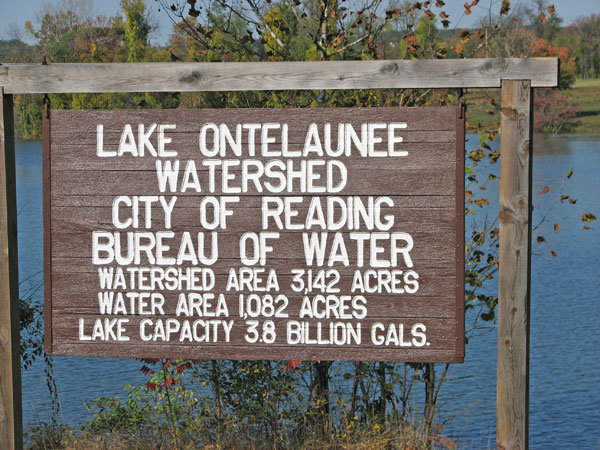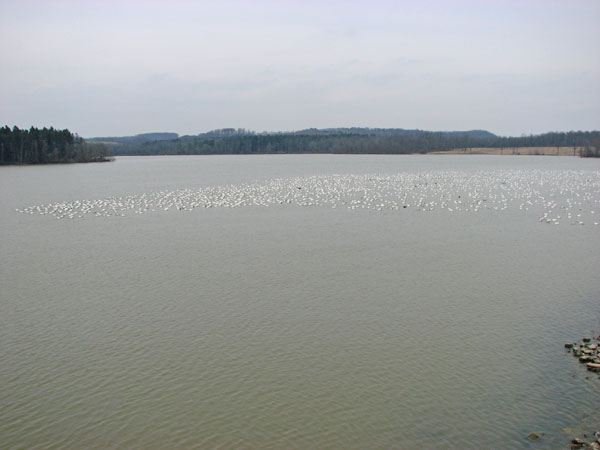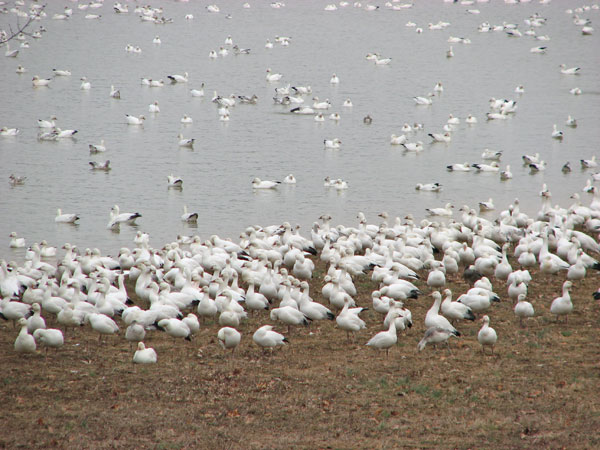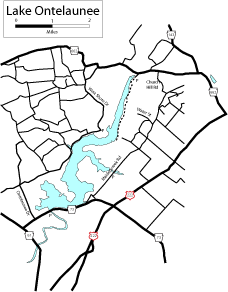
| Berks |
| DESCRIPTION: This 1,080-acre reservoir, regularly birded since its creation in 1929, is best known for attracting an impressive number and variety of water birds, including many rarities over the years. Land birding is also good along the trails through the land surrounding the lake. Make sure to stay out of posted Game Propagation Areas. |
DIRECTIONS: From Reading and the intersection of US 222 and PA 61, go north on PA 61 for 2 miles and turn right on PA 73. Go 0.8 mile and park in the lot at the western end of the dam breast. To reach this parking lot from the intersection of US 222 and PA 73, drive west on PA 73 and cross the bridge over the dam. Scan the lake from the parking lot or from the pedestrian walkway on the bridge. CAUTION: The posted 25mph cross-dam speed limit is not enforced. If you bird from the dam, expect to have noisy vehicles, including heavy trucks, speeding past you at 45 mph a few feet or inches from your back. The dam is one of the best spots for scoping water birds of all kinds, especially in fall, winter, and spring. All of the regularly occurring eastern loons, grebes, swans, geese, and ducks may be seen from here, though not necessarily every year. Many great rarities, including Pink-footed Goose, Common Eider, and Black Guillemot have been spotted from the dam. Tens of thousands of Snow Geese, accompanied by a few Ross' and Cackling Geese, have staged here in February and March since the early 1990s. This is the most reliable place to see the resident Bald Eagle pair, as the birds hunt waterfowl in winter and often perch in the spruces across the lake from the dam. A colony of Cliff Swallows nests on the bridge. In summer, Black-crowned Night-Herons often fish at the base of the spillway. In spring, a walk down the dirt road along the Maiden Creek below the dam should yield migrant songbirds. Drive east on PA 73 for 0.7 mile to a parking lot on the left. This is a good place from which to scope any waterfowl you might have missed at the dam. Listen for Red-breasted Nuthatch in fall through spring and for Pine Warbler in early summer. Continue east on PA 73 for 0.2 mile to an intersection. Turn left on Calcium Road and park in the dirt lot on the left just past the lake shore. Walk along the path to the left, listening for Pine Warbler in the eastern white pines in spring and early summer. Continue along the path, scanning the lake through openings in the trees and listening for songbirds, until you come to a wide, treeless opening at the water's edge. This is another excellent place to see waterfowl, loons, grebes, cormorants, gulls, terns, and herons. In rare drought years when the water level drops in late summer, this is prime shorebirding territory. Retrace your path to the parking lot or follow the old access road (now closed to vehicular traffic) back to Calcium Road, completing a loop back to your car. Continue on Calcium Rd. across the one-lane wooden bridge and turn left on Maidencreek Road toward Peters Creek for 0.9 mile. Park in the first lot on the right (before the road crosses the creek). Some consider the Peters Creek area the best all-around birding spot at Lake Ontelaunee. Explore walled Peters Creek, the ponds and cattail marshes, and walk the grass lanes through meadows, shrubland, open woods, and conifer plantations. With luck during migration, you may find American Bittern, Least Bittern, Sora, Virginia Rail, Common Moorhen, Marsh Wren, and Rusty Blackbird. More regular are Wood Duck, Blue-winged Teal, and other puddle ducks, Ring-necked Duck, Ruddy Duck, Pied-billed Grebe, American Coot and American Woodcock. Pennsylvania's only recorded Masked Duck was seen and photographed here June 13 and 14, 1984. On the other side of Maidencreek Road, follow the fishermen's path to the top of the railroad berm to scan a backwater of the lake. The mature Norway spruces here fed flocks of White-winged Crossbills in the winter and spring of 2009 and regularly host wintering Red-breasted Nuthatches and Winter Wrens. The variety of habitats at Peters Creek guarantees a long list of breeding and migrant songbirds. After birding Peters Creek, you may want to take a short detour to bird the seasonal field pool on Evansville Road, described under Sub-sites. If not, continue on Maidencreek Road from Peters Creek for 1.7 miles through Molltown and turn left on Water Street. Drive till you see two houses straight ahead where Water Street makes a right-angle bend uphill to the left. Park on the shoulder. What appears to be the driveway for the houses is really an access road to the backwaters of the lake. Walk past the iron gate through the woods till you come to the water. The best viewpoint is on top of an abandoned railroad bridge abutment a short distance to the right of the end of the path. In years of low water levels in late summer and fall, this was traditionally the best place (has good morning light) to see shorebirds. Unfortunately, the silt deposits that attracted the shorebirds have been overgrown by invasive purple loosestrife, so now only during severe drought is enough mud exposed to attract them. Resident Mute Swans nest here, uncommon Northern Shovelers may be seen, and teal and other ducks that like shallow water are often seen. This is one of the best spots to see egrets and other herons in summer. Return to Maidencreek Road, turn left and drive one mile to the "twin churches," turning left on Church Hill Road between them. Proceed to PA 662 (0.7 mile). From here, you may want to turn right and drive to Moselem Springs Golf Club, described under Sub-sites. If not, turn left on PA 662, drive 0.5 mile, turn left on Lake Road and follow it to a gate. Park and walk the trail along the northern arm of the lake looking for songbirds and for shorebirds in dry years. Return to PA 662, turn left, cross the bridge over the Maiden Creek and park on the left near the gated access road. Walk along the access road as far as you want. This is an especially pleasant walk on a May or June morning when migrant and breeding birds are in full song. Wood Thrush, Rose-breasted Grosbeak, Baltimore and Orchard orioles will be singing. One or two territorial Prothonotary Warblers have been found (more often heard than seen) along the first half mile of this road in May and early June in recent years. The shallow, swampy coves attract ducks, herons and sometimes beavers. Wildflowers that like limy soil grow on the steep, shady banks and rock outcrops along the road. Meadow flowers that prefer moist soil grow near the water. Continue west on PA 662 for 1.6 miles, turn left onto West Shore Drive and go about 2.1 miles until you reach the west side of the lake. Park in the gravel lot on the left where West Shore Drive bends sharply right. Local birders call this the Bailey Creek area. Walk either of the two gated lanes. The grassy south lane goes straight to the lake (more waterfowl and shorebirds). If you take the more gravelly east lane, veer off on the first grass path to the right to scope a shallow cove that allows fine views of geese, swans, and courting ducks in late winter and early spring, shorebirds in dry years (afternoon light good) and herons all summer. The shrubland along the lanes attracts edge loving songbirds and American Woodcock. Continue along West Shore Drive, following the detour signs around West Shore Bridge, now closed to vehicular traffic. When you reach the end of the detour, park and walk out on the bridge, which allows a panoramic view of the western part of the lake. Cliff Swallows nesting on the bridge may buzz you as you scope for summer water birds and shorebirds in very dry years, when much of the lake in front of you can be mudflats. Loons, grebes, cormorants, Ospreys, and Black Terns are often seen from here in the proper season. Drive a short distance further along West Shore Drive and park on the left where a trash barrel is chained to a tree (called the trash can parking lot by local birders). The broad bay to the right is perhaps the best place to see Common Loons (especially during rainy fallouts in November and April), Red-throated Loons, Red-necked Grebes, other grebes, White-winged Scoter, Surf Scoter, Black Scoter, and Long-tailed Duck, all of which characteristically appear during storms. Pacific Loon has been seen from here. Gulls often stage here in late winter, when Herring Gulls can be seen piratizing large rafts of fishing Common Mergansers, which sometimes contain a few Red-breasted Mergansers. Follow West Shore Drive about 2.5 miles to Ontelaunee Drive. (The private pond you will pass on the left often holds Ring-necked Ducks and sometimes Redheads in late winter and early spring.) Turn left on Ontelaunee Drive and drive one mile to the traffic light on PA 73. If you want to complete your circuit of Lake Ontelaunee, turn left and drive 0.5 mile back to the dam breast, which is always worth a second stop. |
|
Maps - other than Google (Click on map for larger view) |
||
|
Sub-sites
|
||
Photos 


|
||
| Posted: 2009-10-24 00:00:00 Updated: 2010-01-24 00:00:00 |
